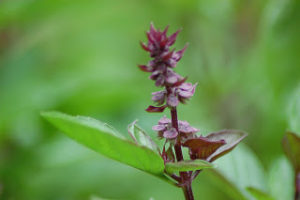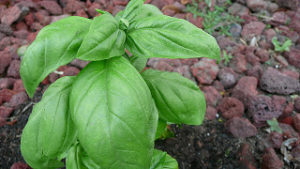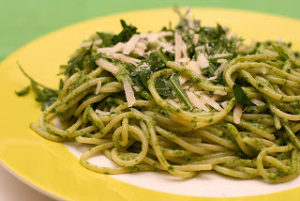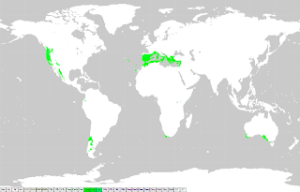Basil originated from India and Southeast Asia and some contend parts of Iran. The Tropic of Cancer, the geographic line which approximates the demarcation of tropic from sub-tropic regions in the Northern Hemisphere, passes through India. Although there are several climate zones and micro-climates in India, it receives a higher average rainfall than most Mediterranean Climates (see Monsoonal climates) and is largely tropical. Similarly, Asian varieties of basil, such as Thai Basil developed in the Southeast Asia, which is predominantly composed of tropical climates.

Image of Thai Basil provided by Choking Sun.
Basil was imported to the Mediterranean Region during the spice trades; some estimate that it made its way to Southern France in the 15th century. The Italians began to cultivate their own species of basil, like Genovese and Sweet basil, for culinary and medicinal applications. After several centuries of cultivation in the Mediterranean, there are now species of basil the grow abundantly in the wild. So technically, there are some species of basil that have evolved and adapted over time to grow natively in a Mediterranean Climate. However, the type of basil that you would normally purchase at at your local garden store such as Sweet or Thai basil will require more water than a typical Mediterranean plant and they are also susceptible to cold weather. But you never know…I’ve planted Genovese and Sweet Basil in the Inland Empire and given them very little water and they have thrived. Go figure.

Image of Sweet Basil provided by Matt Burris.
Now for the part you’ve all been waiting for…the Pesto recipe. Regardless of basil’s characterization as a Mediterranean or non-Mediterranean Herb, we can all agree that its influence on the culinary culture of the Mediterranean Region (let alone the world) has been significant. Anybody who has tried some of grandma’s homemade marinara sauce or finished their plate of pesto pasta longing for seconds knows that basil is a fantastic cooking herb. I’ve checked out a couple of Pesto recipes online and I’ve decided to combine some of the better features of them with my own recipe. So here it is without further ado…
Perfect Pesto
Ingredients:
1 Large Handful of Sweet Basil (you can use Genovese Basil as well)
1/4 cup of toasted walnuts (you can use pine nuts too, but walnuts have a higher fat content and they’re yummy)
1/3 cup of freshly shaved parmesan cheese
3 cloves of fresh garlic
Salt and Pepper to taste
Extra Virgin Olive Oil (add this at the end)
Preparation:
-The key is to hand chop people. I know the fancy gadgetry of the modern age has made us lazy, but I promise you that the twenty minutes or so that it takes to chop everything will be worth it. Some people say that you need a special knife to do this, but I just find the biggest, sharpest blade in my drawer and go to town. The process of chopping is going to allow the essential oils of the basil, walnuts, and parmesan to erupt into an intense flavor cornucopia.
-Chop everything into small pieces, but not too fine because you want to be able to taste the individual ingredients.
-Add all of your chopped ingredients to a mixing bowl and gradually and SLOWLY pour in some extra virgin olive oil. As you pour the oil make sure to stir the mixture quickly to ensure that the small pieces suspend themselves in the oil. Remember: SLOW pour, QUICK stir.
-Now for the final tidbit of advice: try to time this process to finish at the same time that your pasta is finished cooking. Adding that highly aromatic mixture with its fresh oils to hot pasta will seal in the flavor of your mixture. Angel hair or spaghetti pastas both work well with pesto, but pesto makes anything taste great, so experiment and see what tickles your taste buds.

Image of Pesto Dish provided by Katrin Morenz.




